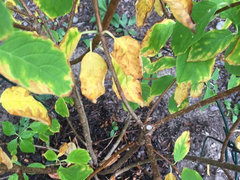The Definitive Guide for Hydrangea Leaves Turning Yellow
Table of ContentsGetting My Hydrangea Leaves Turning Yellow To WorkIndicators on Hydrangea Leaves Turning Yellow You Should KnowHydrangea Leaves Turning Yellow Fundamentals ExplainedExcitement About Hydrangea Leaves Turning YellowThe 45-Second Trick For Hydrangea Leaves Turning YellowThe smart Trick of Hydrangea Leaves Turning Yellow That Nobody is Talking About
Watering your plant with tough water triggers the plant's delegates turn yellow, however the veins will certainly remain green. This condition is called interveinal chlorosis, in which the yellowing is a lot more apparent on the more recent and growing leaves. Nitrogen is a primitive nutrient for plants. It is used in the building and construction of amino acids and for this reason adds to DNA and RNA production.Those indications consist of stunted development and the yellowing of reduced, older fallen leaves in the plant. We're here to assist you with that.
Iron-tone prepares to use and requires no mixing and will bring back deep green color to chlorotic yellow plants, FOR ORGANIC GARDENING: Iron-tone is authorized for natural horticulture; It is a signed up Organic Input Product meaning it fulfills all needs for natural manufacturing, MADE IN THE USA: Product of the Espoma Firm.
Over-watering and under-watering are both damaging to your plant. Make sure you stick with a watering routine that'll fit your plant. Keep in mind to not let the soil dry completely and water the plant once a week. To keep wetness, mulching is suggested. Mulching is adding undecomposed plant material to the soil.
4 Simple Techniques For Hydrangea Leaves Turning Yellow
This is one of the most typical problems that new hydrangea gardeners and skilled experts go via every period. There are a couple of, really common, variables that can trigger your hydrangea leaves to become blemished and brown.
Prior to growing, water the plant. If you have not done this and the plant is currently in the ground this will just take a bit of time and water.
Due to too much fertilization in summer, a burn may appear on the fallen leaves. Hydrangeas do not require also a lot when it comes to fertilizing.
You might notice some brown edges on your fallen leaves. The leaves may become crunchy. This is plant food burn. The burn appears on the fallen leaves, yet that doesn't imply that the fertilizer in fact reached the fallen leaves. Hydrangea Leaves Turning Yellow. This kind of melt generally originates from the roots, which means you could have zapped the roots as well.
Top Guidelines Of Hydrangea Leaves Turning Yellow
If you have located these crunchy fallen leaves on your plant, you can leave them. Or you can snip them off to aid the appearance of your plant. The most typical insects are aphids, crawler mites and beetles. Hydrangeas can have concerns with typical yard pests such as. The feeding wounds of these parasites can turn brownish and trigger brown places to appear on the fallen leaves and stems of the plant.
Knock the beetles into a container of soapy water, or use a strong spray from your tube to interfere with the aphids. You can also spray soapy water onto all of the plant's surface areas.

Copper fungicides are, yet if they are overused they can become toxic to your plant. Clip the leaves, and remove them from the garden.
Excitement About Hydrangea Leaves Turning Yellow
If they aren't obtaining sufficient water, their leaves will brownish. Hydrangeas have a in the lunchtime sunlight, and recovering once additional reading the sun has actually changed and the plants have time to recoup. If this takes place repetitively you might observe brownish and crispy leaves that are drooping. This is their way of letting us understand website link that it needs some added wetness.
!! Water them slowly so the plants can soak up that water. Usually in locations where plants have come to be dried out, the soil is completely dry and the runoff of water becomes a trouble.
Developed plants may require to be sprinkled one to 3 times per week, depending on your conditions. It might appear alluring to spray the leaves down.
Water the base of the plant,. As soon as the plant has rebounded, you can return to a normal watering schedule. Many varieties and varieties choose partial sun. Panicle hydrangeas enjoy complete sun, but the remainder of the group really likes partial shade. Partial color provides about four to six hours of sunlight.
The Best Strategy To Use For Hydrangea Leaves Turning Yellow
You can try to avoid fungal illness by keeping your gardens neat and totally free of debris. These fallen leaves that will certainly stick around, waiting to attack in the next growing period.

If they aren't obtaining adequate water, their fallen leaves will brown. Hydrangeas have a in the midday sunlight, and jumping back when the sun has moved and the plants have some time to recuperate.
!! Water them gradually so the plants can soak up that water. Usually in locations where plants have come to be dried out, the soil is dry and the drainage of water ends up being a problem.
See This Report on Hydrangea Leaves Turning Yellow
Established plants might need to be watered one to 3 times per week, depending on your problems. It may seem alluring to spray the fallen leaves down.
Water the base of the plant,. Once the plant has rebounded, you can resume a routine watering routine.